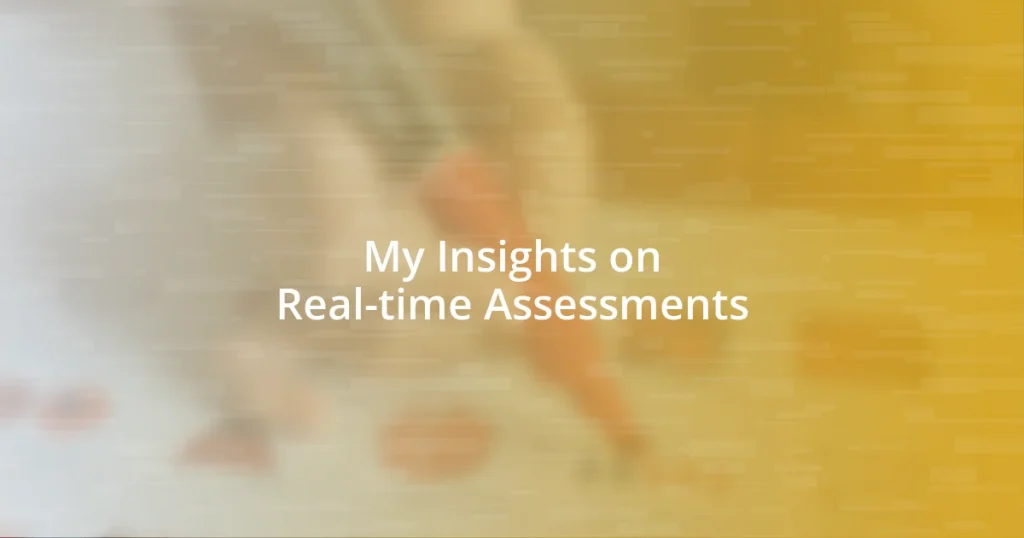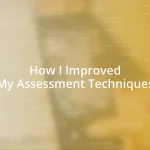Key takeaways:
- Real-time assessments enhance learner engagement through immediate feedback and data-driven insights, enabling instructors to adapt teaching strategies effectively.
- Utilizing interactive tools like Kahoot and Poll Everywhere creates a dynamic learning atmosphere, fostering collaboration and excitement among students.
- Implementing a structured feedback loop and celebrating incremental successes contribute to continuous improvement in both teaching methods and student learning experiences.

Understanding real-time assessments
Real-time assessments provide immediate feedback on a learner’s performance, allowing for a more dynamic and responsive educational environment. I remember a time when I conducted a quick quiz during a workshop, and it was amazing to see how quickly participants adjusted their understanding based on the instant results. This level of immediacy not only keeps learners engaged but also fosters a deeper connection with the material.
One of the defining features of real-time assessments is their ability to pinpoint specific areas where a learner struggles. It’s like having a personalized tutor right there with you. Have you ever felt the frustration of preparing for an exam only to discover the night before that you weren’t clear on crucial concepts? Real-time assessments can help alleviate that pressure by identifying gaps in knowledge as they arise.
Moreover, the data collected during these assessments can be invaluable for instructors. I’ve had instances where analyzing real-time feedback allowed me to pivot my teaching strategy mid-session, tailoring my approach to meet the needs of my audience on the spot. It’s fascinating to think about how real-time assessments enable educators to create a more tailored and effective learning experience, making education a collaborative journey rather than a one-size-fits-all approach.

Benefits of real-time assessments
Real-time assessments offer the unique advantage of fostering greater student engagement. I recall a particularly lively class where I implemented interactive polls. Watching students respond in real-time not only revealed their understanding but also sparked vibrant discussions that enriched our learning experience. Knowing that their answers had immediate consequences encouraged students to be more invested in the subject matter.
Additionally, the ability to track progress instantaneously is a game-changer. When I’ve used real-time assessments, I’ve noticed that learners appreciate seeing their growth unfold right before their eyes. It reminds me of when I used a live leaderboard during a training session; participants were motivated not just to learn but to improve. This visibility supports a growth mindset, encouraging learners to take ownership of their journey.
Let’s not forget the actionable insights that real-time assessments provide for educators. For instance, after a workshop, I analyzed feedback from interactive quizzes. The results highlighted knowledge gaps that I was previously unaware of, which empowered me to refine my future content. This data-driven approach transformed not just my teaching methods but also enhanced the learners’ experiences, creating a feedback loop that ultimately benefits everyone involved.
| Benefit | Description |
|---|---|
| Immediate Feedback | Quick insight into learner understanding and areas needing improvement. |
| Increased Engagement | Real-time responses promote active participation and interest in the material. |
| Data-Driven Insights | Edit and improve teaching methods based on learner progress and feedback. |

Key tools for real-time assessments
When it comes to tools for real-time assessments, there are several that stand out in my experience. For instance, I find interactive quiz platforms like Kahoot and Poll Everywhere to be incredibly effective. They create an exhilarating atmosphere in the classroom—participants get a thrill from competing against each other, making learning feel like a game. I remember using Kahoot once during a training session, and the energy in the room was electric; it transformed a standard review into a fun and dynamic learning experience.
Here are some key tools worth considering for real-time assessments:
- Kahoot: Engages learners with gamified quizzes that spark competition and excitement.
- Poll Everywhere: Allows instant polling and feedback, fostering discussion and immediate clarity.
- Nearpod: Combines interactive lessons with quizzes and polls for comprehensive engagement.
- Google Forms: Simple yet versatile for collecting real-time responses, it’s an excellent tool for quick assessments.
- Socrative: Offers instant insight into student understanding, with versatile quiz options and immediate reporting.
Utilizing these tools not only enriches the learning experience but also makes it enjoyable. I must say, it’s rewarding to observe how these assessments can light up a learner’s face when they grasp a concept that previously seemed elusive. It’s a powerful reminder of the impact that real-time feedback can have on motivating learners and helping them flourish in their educational journeys.

Implementing real-time assessments in classrooms
Integrating real-time assessments in classrooms requires thoughtful planning and execution. I remember a time when I unexpectedly introduced an exit ticket system right at the end of my lesson. It was fascinating to see students not only share their thoughts on what they had learned but also express any lingering confusion in a matter of minutes. This immediate feedback loop made them feel valued and heard—something that transformed an ordinary class closure into a reflective moment.
During implementation, it’s essential to create a comfortable environment where students feel safe to express themselves honestly. I’ve found that encouraging open dialogue during these assessments fosters trust and creates an atmosphere where students are willing to take risks with their learning. Have you ever noticed how honesty flourishes in space where vulnerability is welcomed? By embracing this, I’ve been able to significantly enhance student participation and motivation.
As I refined my approach to real-time assessments, I also discovered the power of varied formats. Mixing quick quizzes with interactive discussions enabled me to cater to different learning styles, making the experience more inclusive. The joy on a student’s face—when a previously puzzling concept suddenly clicks—reminds me of why I’m so passionate about this practice. It’s moments like these that reaffirm my belief in the value of real-time assessment as a transformative element in the educational journey.

Strategies for effective assessments
One effective strategy for real-time assessments is to consistently vary the assessment methods. I recall experimenting with a combination of think-pair-share and real-time polling during a workshop. The shift in dynamics was palpable; when participants collaborated first, their confidence in answering later was much higher. It made me wonder, don’t we all thrive in collaborative spaces where ideas can bounce around freely?
Additionally, timing plays a crucial role in the impact of assessments. I once timed a quiz right after a particularly challenging concept had been covered. The surprising part? The immediate feedback from that quiz allowed me to address misconceptions on the spot. It’s somewhat exhilarating, don’t you think, to think you can pivot a lesson based on real-time insights?
Finally, incorporating reflective practices is a game changer. After every assessment, I encourage learners to jot down their thoughts on what worked well for them and what didn’t. I still remember one student sharing how a particular question sparked more curiosity about the subject. Moments like that highlight the real value of assessments—not just in evaluating knowledge, but in fostering a love for learning itself.

Analyzing data from real-time assessments
Analyzing data from real-time assessments is a dynamic process that can truly illuminate student understanding. I’ve often found myself sifting through the responses to quick polls right after a lesson. The correlations between student answers and their overall engagement can be striking. For instance, during a recent session, I noticed that students who struggled with a particular topic often shared similar misconceptions. It made me think, isn’t it amazing how these insights can guide our instructional choices almost immediately?
One memorable occasion was when I utilized an app to analyze students’ quiz results in real-time. The analytics provided instant feedback, allowing me to adjust my teaching strategy on the fly. Seeing which questions stumped the majority helped me identify areas that required further clarification. I’d ask myself, how often do we get the chance to respond to students’ needs right in the moment? That was illuminating—not only for me but for the class as we collaboratively unraveled the complexities of the topic together.
Moreover, I’ve come to appreciate that analyzing data isn’t just about numbers; it’s also about understanding emotions. The day I presented results of a reflective survey, I noticed the students’ eyes widen as they recognized their growth. It was a pivotal moment—one that reaffirmed my belief that data can serve as a powerful motivator. Isn’t it compelling how real-time assessments can help us foster a positive and growth-oriented learning environment? Seeing students light up with pride over their progress makes me passionate about integrating data analysis into my teaching practice even more.

Best practices for continuous improvement
To maintain continuous improvement in real-time assessments, it’s essential to establish a feedback loop that encourages open communication. I remember a time when I implemented anonymous feedback forms after each assessment. The insights I gained were enlightening; students felt more comfortable sharing their honest opinions about what they found challenging. Isn’t it intriguing how anonymity can empower learners to express themselves more freely? This practice not only highlighted areas for improvement but also fostered a culture of trust.
Regularly revisiting and refining assessment criteria is another best practice that I find invaluable. I once had a colleague who adjusted the rubric for a group project based on students’ feedback from previous iterations. The clarity in expectations transformed how students approached their work. It made me realize how vital it is to adapt our methods; after all, isn’t education about growth—for both students and educators alike?
Lastly, I believe that celebrating incremental successes plays a crucial role in motivating learners. During one of my classes, I introduced “mini-celebrations” for achieving small milestones in understanding. Those moments of recognition sparked a palpable excitement among students, urging them to strive for even more progress. Reflecting on that experience, it’s clear that continuous improvement isn’t solely about fixing what’s broken; it’s also about acknowledging achievements to fuel future ambitions. Don’t we all thrive on encouragement?















